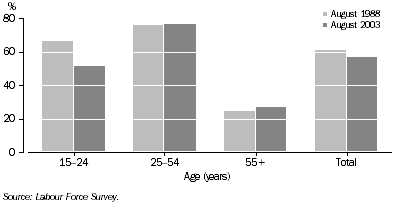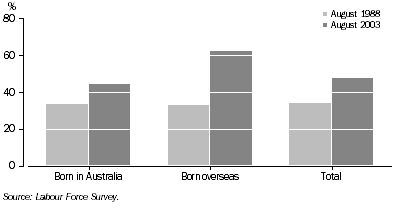Feature Article - Spotlight on Country of Birth
This article was published in the October 2003 issue of Australian Labour Market Statistics (cat. no. 6105.0).
INTRODUCTION
This article examines the labour market experience of migrants, and how this has changed over time, using data from the Labour Force Survey (LFS). The LFS collects data on country of birth and year of arrival in Australia from those respondents born overseas. Summary data is published in table 1.5 of this publication.
Country of birth information is available at a more detailed level from the Census of Population and Housing. The census data are more suitable for detailed analysis, but are only available every five years, while the LFS data provide a more frequent time series.
Country of birth is classified according to the Standard Australian Classification of Countries (SACC) (cat. no. 1269.0). This classification was adopted by the ABS in September 1998, replacing the Australian Standard Classification of Countries for Social Statistics (cat. no. 1269.0). Concordances between the two classifications are available.
SOURCE OF MIGRANTS
In the August 2003 LFS, 27% of the civilian population aged 15 and over were born overseas. Of these, 19% arrived in Australia during the period 1996-2003, and for the purposes of this article are referred to as 'recent arrivals'.
Country of birth(a): Original—August 2003 |
|  |
 |  |  | Civilian population aged 15 and over
| Unemployment rate | Participation rate |  |
| Country of birth |  |  | '000 | % | % | % |  |
|  |
| Born overseas and arrived recently |  |  |  |  |  |
 | Oceania and Antarctica | 113.4 | 13.9 | 7.4 | 75.9 |  |
 |  | New Zealand | 89.7 | 11.0 | *5.5 | 79.1 |  |
 | North-West Europe | 113.4 | 13.9 | *3.5 | 70.9 |  |
 |  | UK and Ireland | 89.0 | 10.9 | *3.4 | 75.1 |  |
 | Southern and Eastern Europe | 61.7 | 7.6 | 14.1 | 56.4 |  |
 | North Africa and the Middle East | 50.4 | 6.2 | 30.4 | 38.5 |  |
 | South-East Asia | 142.5 | 17.5 | 11.7 | 48.1 |  |
 | North-East Asia | 161.2 | 19.8 | 13.8 | 35.6 |  |
 |  | China (excludes SARs and Taiwan) | 89.1 | 10.9 | 15.8 | 37.0 |  |
 | Southern and Central Asia | 80.4 | 9.8 | *7.9 | 66.4 |  |
 |  | India | 42.2 | 5.2 | *7.2 | 69.0 |  |
 | Sub-Saharan Africa | 58.5 | 7.2 | *6.1 | 75.4 |  |
 |  | South Africa | 34.5 | 4.2 | *4.4 | 79.7 |  |
 | Americas | 34.5 | 4.2 | *10.3 | 58.8 |  |
 | All recent arrivals(b) | 816.1 | 100.0 | 9.7 | 56.9 |  |
| Born overseas | 4,367.0 | 27.4 | 5.9 | 56.8 |  |
| Born in Australia | 11,287.2 | 70.9 | 5.5 | 66.9 |  |
| Total(c) | 15,930.7 | 100.0 | 5.6 | 63.0 |  |
|  |
| * estimate is subject to sampling variability too high for most practical purposes |
 |  |  |  |  |  |  |  |
| (a) Classified according to the Standard Australian Classification of Countries (SACC), 1998 (cat. no. 1269.0). |
 |  |  |  |  |  |  |  |
| (b) Includes all countries, and persons born at sea. |
 |  |  |  |  |  |  |  |
| (c) Includes institutionalised persons, for whom country of birth is not determined. |
 |  |  |  |  |  |  |  |
| Source: Labour Force Survey. |
In August 2003, 47% of recent arrivals were born in Asia, with 22% born in Europe and 14% born in Oceania and Antarctica. The remaining 18% were born in Sub-Saharan Africa (7%), North Africa and the Middle East (6%), and the Americas (4%). Of the recent arrivals, more were born in New Zealand (11%) than any other individual country.
LABOUR FORCE STATUS
In August 2003, recent arrivals had a higher unemployment rate (9.7%) than all migrants (5.9%) or the Australian-born (5.5%). Participation rates were similar for recent arrivals and all migrants (57%), but lower than that for Australian-born residents (67%).
CHANGING EXPERIENCE OVER TIME
Between August 1988 and August 2003, the labour force participation rate of migrants fell from 61% to 57%, largely because of a decline in the participation rate for migrants aged 15-24 years.
Persons born overseas, Participation rates by age—1988 and 2003

This youngest group experienced a drop in their participation rate from 67% to 52%. This is due partly to an increase in the full-time education retention rate in Australia in this age group, and to a large increase in the number of people coming to Australia to study.
Proportion attending full-time education, Persons aged 15–24

Between August 1988 and August 2003 the proportion of migrants aged 15-24 years who were attending full-time education almost doubled, from 33% to 62%. In August 2003 the labour force participation rate for migrants aged 15-24 years in full-time education was 33%, compared with 83% for those not in full-time education.
 Print Page
Print Page
 Print All
Print All